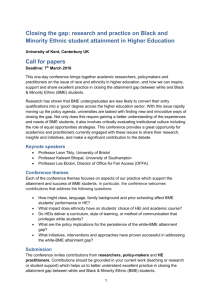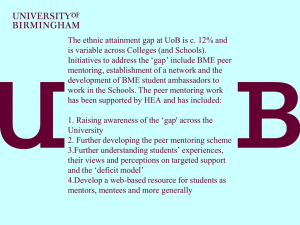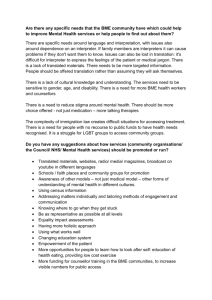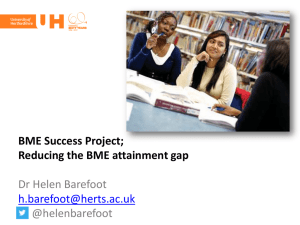The Black Student Experience in Higher Education
advertisement
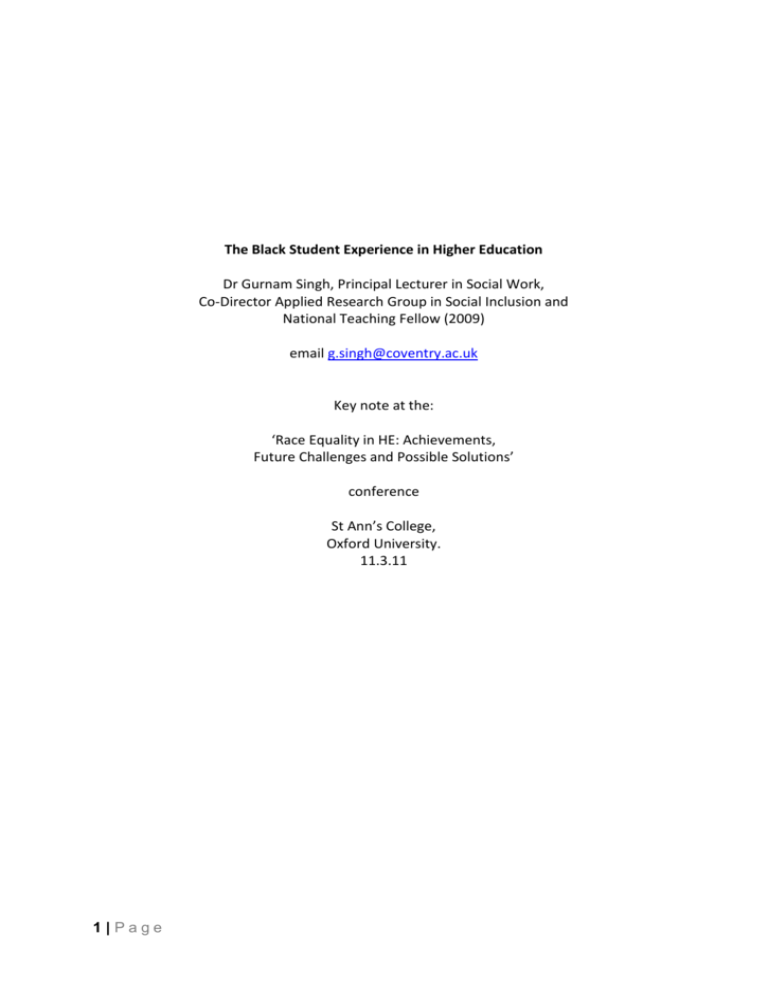
The Black Student Experience in Higher Education Dr Gurnam Singh, Principal Lecturer in Social Work, Co-Director Applied Research Group in Social Inclusion and National Teaching Fellow (2009) email g.singh@coventry.ac.uk Key note at the: ‘Race Equality in HE: Achievements, Future Challenges and Possible Solutions’ conference St Ann’s College, Oxford University. 11.3.11 1|Page Can I begin by thanking Leyla Okhai for organising this important historic event. I feel particularly honoured to have been asked to share my thoughts about the question of ‘race’ equality in Higher Education (HE). In thinking about my presentation, and being conscious of being at an institution which, along with its younger sister (or should it be brother) institution approximately 70 miles due East, has become something of a punch bag when it comes to questions of snobbery and elitism, I was determined not to make any cheap shots along the lines of the Laura Spence affair in 1999 and Gordon Browns assertion that this was scandalous, or the more recent observations made by the Labour MP and former minister for Higher Education David Lammy, in the Guardian of 6th Dec 2010 titled ‘The Oxbridge Whitewash’ in which he alleged that there was widespread nepotism operating at Oxbridge to the detriment of students from black, working class and northern backgrounds. The other cliché about Oxford is to liken it to an educational dinosaur. Of course this is a completely false comparison, for dinosaurs have been extinct for millions of years and Oxford is alive and kicking. The major causes of extinction in the natural world where habitats change quicker than the capacity for the organism to adapt/evolve. The fact that Oxford, the oldest university in the world still remains at the top of the ‘food chain’ is clear evidence of its capacity to change, albeit in a somewhat cautious manner. Over the centuries Oxford has both shaped and reflected the prevailing world view, but just as women on the misplaced view that higher education was not relevant to their role in society were not allowed to take degrees at the University until 1920, today in the 21 st Century in the post colonial post industrial period, universities like Oxford face another challenge. In a age where the idea mass as opposed to an elite higher education system, where ideologies of inherent inferiority human beings based on such things as ‘race’, class, gender, disability, age and so are no longer tenable, both morally and legally, our so called ‘elite institutions’ once again are faced with the necessity adapt. Putting aside the moral arguments, if the so called Russell Group wants to maintain their world class status then, on the presumption that intellectual potential is broadly evenly distributed amongst the whole population, it is seems foolish to only fish for talent restricted to a small pool of 18 year old’s taken from the ‘traditional’ recruiting grounds. Initially it was suggested to me by Leyla that I should focus my talk on the question ‘does meritocracy exist in Higher Education?’ As you can see from the programme, I declined; not because the question of meritocracy is not important, but because I didn’t think that I would be able in the format of a keynote do justice to it. Let me explain. In many ways the question of meritocracy constitutes a key organising principle of the European Enlightenment which sought to enunciate two linked cardinal principles; first, the idea that life chances should not be ‘accidents of birth’ and second that mass and not selective or elite participation in education was the hallmark of modern democratic societies. Founded on the principles of reason, justice and the idea of the common public sphere (Melton, 2001), enlightenment scholars sought to critique and challenge the territory that 2|Page was the sole preserve of state and religious authorities. It was a period of slaying sacred cows and a reassessment of what it was meant to be human. One of the most influential of all thinkers, John Locke, who was associated with Christ Church College here at Oxford, through his theory of the consciousness which proposed that the human mind was a blank slate or ‘tabla rasa’, and by doing so he asserted that human ontology was not subject to innate ideas and that the possession of knowledge was the product of lived experience. Leading to the assertion, later to be reflected in the American Declaration of Independence, that ‘men [sic] are created equal’, we can see this idea giving birth a whole new way of viewing human worth and potential. It was this very idea of the blank slate that was later to inspire the work of the radical behaviourist John Watson captured in his contention that if her were given ‘a dozen healthy infants, well-formed, and [his] own specified world to bring them up in [he would] guarantee to take any one at random and train him to become any type of specialist I might select - doctor, lawyer, artist, merchant-chief and, yes, even beggar-man and thief, regardless of his talents, penchants, tendencies, abilities, vocations, and race of his ancestors.”(Watson, 1930) So whilst the enlightenment offered the tantalising possibility of a meritocratic society, the reality is somewhat different. The belief that we are all equal at birth is no guarantor of equality of outcome, which most reasonable people now accept is determined by a wide range of social, economic and cultural factors. As the overwhelming evidence states, the ‘more black and working class one is the more likely one is to end up in low prestigious institutions and the more white and middle class one is the reverse is the case (HEFCE, 2010), a state of affairs that is dramatically illustrated with the often quoted statistic that there are more Black students at London Metropolitan university than the entire Russell Group. And once in the institutions, the disparities continue, with BME students up to 3 times less likely to get a first. And up to 2 times less likely to get a 2:1 So, in focussing my talk more directly on the Black Student experience of HE, I am specifically seeking to do two things: first to problematise current approaches to diversity in higher education and second to offer some means of responding to the issue BME participation and attainment in HE, something that has been the focus of my research for some years. In terms of the question of diversity, my basic premise is that the notion of ‘diversity’, as it currently deployed in educational and other public - and increasingly private sector institutions, has singularly failed to address the issue of institutional and structural discrimination and disadvantage. That, as a consequence of complex and contradictory forces, associated with, amongst other things, postmodernist (diversity as ‘inherently good’) and neo-liberal conceptions (diversity as fetish and commodity), struggles for and over diversity have been stripped of their historical, material and emancipatory thrust. If I were to conduct a poll of people in this audience on the proposition that celebrating diversity was a good thing, most would agree! We are all self evidently diverse and living in a world where everybody looks and behaves like oneself conjures a somewhat dystopian hellish image. So why you might think am I wanting to problematise the idea of diversity in 3|Page Higher Education, which seems like a self evidently positive and desirable thing to celebrate. Well, the issue isn’t so much about the value of celebrating diversity per say but about how the term is understood and how can policies built around diversity address the deeper questions related to structural inequalities, racism and oppression. Whilst it would be disingenuous to suggest all advocates of diversity policies in universities sing from the same hymn sheet, there is good reason to believe that ‘diversity’ enters higher education less through an emancipatory imperative, reflected perhaps most clearly in the political discourse of anti-racist education, and more via the neo-liberal marketisation agenda that has taken such a stranglehold on Higher Education. Specifically in Education, diversity discourses have been articulated in terms of ‘widening participation’ and ‘internationalisation’, which in turn are justified in relation to neo-liberal imperatives of ‘the market’, ‘economic competitiveness’ and ‘economic globalisation’ (Canaan and Shumar, 2008) Specifically, the idea of diversity has become taken up by universities in two distinct ways, to ‘manage diversity’, and/or turn diversity into a commodity, a marketing tool to maximise market share. Ahmed (2007) argues such strategies ‘work to individuate difference and to conceal the continuation of systematic inequalities within and between universities. She illustrates this point by pointing out how diversity becomes synonymous with certain conceptions of a university. On the one hand we have the ‘widening participation’ university for whom the appeal to diversity becomes a kind of ‘race to the bottom’, a means to ensuring they meet their recruitment targets; conversely, for the ‘elite’ the appeal to diversity becomes associated with their claims to be truly global institutions and ‘diversity becomes a means by which certain others, who are ‘global citizens’, can be appealed to. In short, whether it is a race to the bottom or top, diversity becomes an instrument or technique not only for attracting people to the university, but also for dealing with differences within the lived environment of the university. Doing diversity here is not associated with challenging disadvantage, but doing business for different kinds of neoliberal universities. In this sense, diversity has become instrumental in masking arguably the most significant axis of diversity, namely, that of class and wealth (Michaels, 2006). If one looks more directly at the black student experience of HE, it would be wrong to suggest that everything is bad; there are some good news stories to tell, both at an institutional and individual level. So, whilst, as noted earlier, there are some significant variation across the HE sector as a whole and amongst different ethnic groups, broadly speaking successive government policies aimed at expanding HE and widening participation over the past 20 years have been hugely successful. From the turn of the century, BME students were reported to comprise 16% of the undergraduate population in England as opposed to 9% of the working population (Connor et al., 2004). However, if the headline figures look promising, when one looks at the experience of BME students within HE, both subjective and objective measures uncover some worrying evidence. Although unequal patterns of attainment between BME groups and White students were pointed out in the late 1990’s by Bhattacharyya et al. (2003), up until recent times higher education (HE) in the UK has been relatively immune from scrutiny regarding the racial and ethnic dynamics of universities which, as a result have, by and large, been concealed (Deem 4|Page et al. 2005; Law et al., 2004). Whilst such a state of affairs was politically sustainable under conditions where HE was only accessed by a small and largely privileged section of the population, under government policies of expansion, fair access and widening participation (DfES, 2003), things have dramatically changed. As a consequence of greater scrutiny through such bodies as the Higher Education Funding Council (HEFCE), tighter statutory requirements brought about as a consequence of the Race Relations Amendment Act (2000), and through various empirical studies, we now have an increasing body of evidence uncovering the experiences of BME students in HE. The evidence indicates that BME students face inequality at all stages of the HE experience: they are less likely to be satisfied with their student experience; more likely to leave early; and are less likely to gain a good honours degree (1st or 2:1) (Connor et al., 2003 and 2004). More so, Connor et al also argue that progression to employment may not be as successful or straight forward for BME graduates. In terms of this last point on degree attainment, there is clear evidence that students from certain BME groups under-perform on a range of measures compared to White students (Broecke and Nicholls, 2007; Higher Education Academy/Equality Challenge Unit Final Report, 2008). The picture is complex and the reasons why the degree attainment gap exists for any individual are varied (e.g. gender, disability, social deprivation, previous family educational experiences of HE, type of institution and whether student is home or campus based). Nonetheless, there is a growing body of evidence that confirms that ‘even after controlling for the majority of factors which we would expect to have an impact on attainment, being from a minority ethnic community…is still statistically significant in explaining final attainment’ (Broecke and Nichols, 2007:3). The cause for this statistically significant attainment gap is yet to be fully understood, although the possible role of racism is one factor that has in recent years been given increasing significance (Turney et al. 2002; Back, 2004). Les Back in a book entitled Institutional Racism in Higher Education suggests that the self concept that ‘White’ academics align themselves to the ‘liberal minded rational intellectuals’, coupled with a notion that racism is the product of small minded, morally degenerate hateful individuals, is the perfect formula for locating the problem somewhere else. He goes on to argue that there is a need for a shift in mind set to an acknowledgement that our capacity to reason is never absolute and ‘that racism has damaged reason, damaged academic and civic freedoms and damaged the project of education itself’ (Back, 2004 p5). Hence, whilst it is not unreasonable to take pride in the broadly free, open and tolerant ethos that HE aspires to, at the same time there needs to be recognition that, like other institutions, universities are not immune from institutional racism. In terms of policy development, particularly over the past 10 years the literature suggests an important shift away from a defensive posture associated with fulfilling legislative and regulative requirements, to more proactive responses aimed at developing pedagogical strategies for addressing BME student attainment. The publication of the Macpherson report in 1999 into the death of Stephen Lawrence, coupled with the broader widening participation agenda set in train earlier, not only 5|Page significantly raised the profile of race equality in HE, but also for the first time made it a legal requirement for universities to look at and publish statistics on BME student attainment. My own research on the published research suggests that whilst the more targeted initiatives stemming from the Race Relations (Amendment) Act 2000 initially had an impact, it is still broadly the case, and particularly so in the Russell Group, that many universities either remain in a state of denial about the BME attainment gap, or tend to reduce the issue to one of celebrating and managing diversity and student deficit models where in effect their perceived lack of ability is seen as the primary cause for their relative lower attainment (Turney et al., 2002; Jones and Thomas, 2005; Jacobs et al., 2007; Ahmed, 2007). But it would be wrong to simply blame universities for the problem – there is, for instance much evidence suggesting that pre-university attainment of many groups within the BME categorisation does have some bearing on subsequent performance at HE (Gorard et al. 2006; Broecke and Nicholls 2007; Richardson, 2008; Morrice, 2009). Yet, however appealing it might be to identify one single major cause that could explain the BME attainment gap, a more plausible explanation would lead to a complex range of differently connected factors such as; previous educational experiences, curriculum content and design, teaching learning and assessment approaches, the learning environment and direct and indirect racism are all at play (Bird, 1999; Turney et al. 2002; Back, 2004; Tolley and Rundle, 2006; NUS, 2011). So, given the evidence, the question remains, what can be done to address the issues? First of all one needs to recognise that different institutions, departments and courses have different priorities; for some the issue is recruitment, whilst for others it is about retention and success. I would just like to end by offering a selection of some practical steps which could be taken – these are drawn from a systematic review of the literature which I recently undertook for the HEA which should be published very soon (Singh, 2011): A: Teaching, learning, curriculum and assessment. 1. Every effort must be made to avoid pathologising lower attainment and therefore it is important to focus on strategies for success and not reasons for failure when seeking to enable students to improve on their performance. 2. In an increasingly globalised higher education system, for the benefit of ‘home’ and ‘international students’, the academic curriculum needs to be genuinely international in relation to content. 3. Course materials and case studies should seek to represent ‘non-western’ minorities in a balanced way and not just in the context of social problems or as victims. 4. Diverse and creative assessment strategies should be developed although all existing and new strategies should be reviewed and changed to avoid/minimise bias. B: Leadership and management. 1. Institutions, irrespective of where they are located, need to work to establish meaningful and sustained links and partnerships with BME communities and organisations at a local, regional and in some instances, national and international level. 6|Page 2. The institutional human resources strategy in terms of recruitment, selection, retention and development should be informed by the need to develop a culturally diverse and competent workforce. 3. The university registry should establish an effective system to generate data in relation to ethnicity and attainment that can be drilled down to different levels 4. Universities need to challenge campus racism, actively discourage segregation and encourage cohesion amongst students through a range of reactive and proactive actions. 5. Whilst it is important to reflect diversity in all university publicity material, care should be taken to ensure that external representation of diversity and harmony is a true reflection of the internal culture and experience of students. 6. Elite universities need to become more/welcoming and open to students who may not have succeeded in education first time round. C: Student support services 1. Whilst the core of university life should be based on a secular ideal, given that for significant numbers of students faith and spirituality are important dimensions of their lives, universities should proactively recognise and accommodate these students’ needs. 2. Whilst BME students’ particular needs, as learners, should be addressed, this should be done in a non-stigmatising way that does not reinforce a ‘deficit model’. 3. Mentoring schemes and positive role models can be very effective, but as with the point above, these should be developed in ways that do not end up reinforcing a deficit model and/or the segregation of BME students. References Ahmed, S. (2007a) “You end up doing the document rather than doing the doing”: Diversity, Race Equality and the Politics of Documentation. Ethnic and Racial Studies, 30:2,2. Back, L. (2004) Introduction, in, Law, I., Philips, D. and Turney, L . (2004) Institutional Racism in Higher Education. Stoke on Trent: Trentham.. Bhattacharyya, G., Ison, L., and Blair, M. (2003) Minority Ethnic Attainment and Participation in Education and Training: The Evidence. DfES Research Topic Paper RTP01-03. Bird, J. (1996) Black students and higher education: rhetorics and realities. Buckingham: Society for Research into Higher Education and Open University Press. Broecke, S. and Nicholls, T. (2007), Ethnicity and Degree Attainment, Department for Education and Skills Research Report RW92. Available on-line from: www.dfes.gov.uk/research/data/uploadfiles/RW92.pdf [Accessed 12.08.09] Canaan, Joyce E and Shumar, Wesley, eds. (2008) Structure and Agency in the Neoliberal University, Routledge: New York and London 7|Page Connor, H., Tyers, C., Modood, T. and Hillage, J. (2004) Why the difference? A closer look at higher education minority ethnic students and graduates (Research Report No. 552). London: Department for Education and Skills. Available on-line from: http://www.employment-studies.co.uk/pubs/summary.php?id=rr552 [Accessed on 12.08.09] Demie, F. (2004) Achievement of Black Caribbean pupils: good practice in Lambeth Schools. British Education Research Journal, 31, 4. DfES (2003a) Widening Participation in Higher Education. London, Department for Education and Skills. http://www.bis.gov.uk/assets/biscore/corporate/migratedd/publications/e/ewparticipation .pdf [Accessed 18/07/2010] Gorard, S., Smith, E., May, H., Thomas, L., Adnett, N. and Slack, K. (2006) Review of widening participation research: addressing the barriers to participation in higher education. A report to HEFCE by the University of York, Higher Education Academy and Institute of Access Studies. Available on-line from: http://www.hefce.ac.uk/pubs/RDreports/2006/rd13_06/ [Accessed 10.10.09] HEFCE (2010) Student ethnicity - Profile and progression of entrants to full-time, first degree study. Higher Education Funding Council for England. Higher Education Academy/Equality Challenge Unit (HEA/ECU) (2008), ‘Ethnicity, Gender and Degree Attainment Project – Final Report’. Available on-line from: http://www.heacademy.ac.uk/assets/York/ documents/ourwork/research/Ethnicity_Gender_Degree_Attainment_Jan08.pdf [Accessed 08.09.09]. http://www.hefce.ac.uk/pubs/hefce/2010/10_13/ [Accessed 10.1.2011] Jacobs, S., Owen, J., Sergeant, P. and Schostak, J. (2007) Ethnicity and gender in degree attainment: an extensive survey of views and activities in English HEIs. London, and Equality Challenge Unit Report November, 2007. http://www.ecu.ac.uk/documents/projectfiles/ethnicity-and-degree-attainment-files/s-jacobs-perceptions-survey-jan08.doc/view Jones R. and Thomas L. (2005) “The 2003 UK Government Higher Education White Paper: a critical assessment of the implications for the access and widening participation agenda”, Journal of Education Policy 20 (5) 615-630 Law, I., Philips, D and Turney, L (2004) Institutional Racism in Higher Education. Trehtham, Stoke on Trent. Melton, J (2001) The Rise of the Public in Enlightenment Europe". Cambridge: Cambridge University Press Michaels, W. B (2006) The Trouble with Diversity: How We Learned to Love Identity and Ignore Inequality. 8|Page Morrice, L. (2009), Journeys into higher education: the case of refugees in the UK, Teaching in Higher Education, 14, (6), pp. 661 – 672. NUS (2011) Black Students Experience - Interim Report, London, National Union of Students. Available on-line at: http://www.nusconnect.org.uk/asset/news/6016/NUS-Black-studentsreport-web.pdf [12.01.11] Richardson, J.T.E. (2008) The attainment of ethnic minority students in UK higher education. Studies in Higher Education. 33, 33-48. Singh, G (2011) Black and Minority Ethnic (BME) students participation and success in Higher Education: improving retention and success: A Synthesis of Research Evidence. York, Higher Education Academy. Tolley, J. and Rundle, J. (2006), A Review of Black and Minority Ethnic Participation in Higher Education, Aim higher National Project. Available on-line from: http://www.ahgtm.ac.uk/uploads/documents/nov_07/aim_1195047372_BMEHEreview_.pd f [Accessed 10.11.09] Turney, L., Law, I. and Phillips, D. (2002) Institutional Racism in Higher Education Toolkit Project: Building the Anti-Racist HEI. Available on-line from: http://www.leeds.ac.uk/cers/toolkit/Section%20One.htm [Accessed 10.11.09] Watson, J.B. (1930) Behaviourism. Chicago, University of Chicago Press) 9|Page
